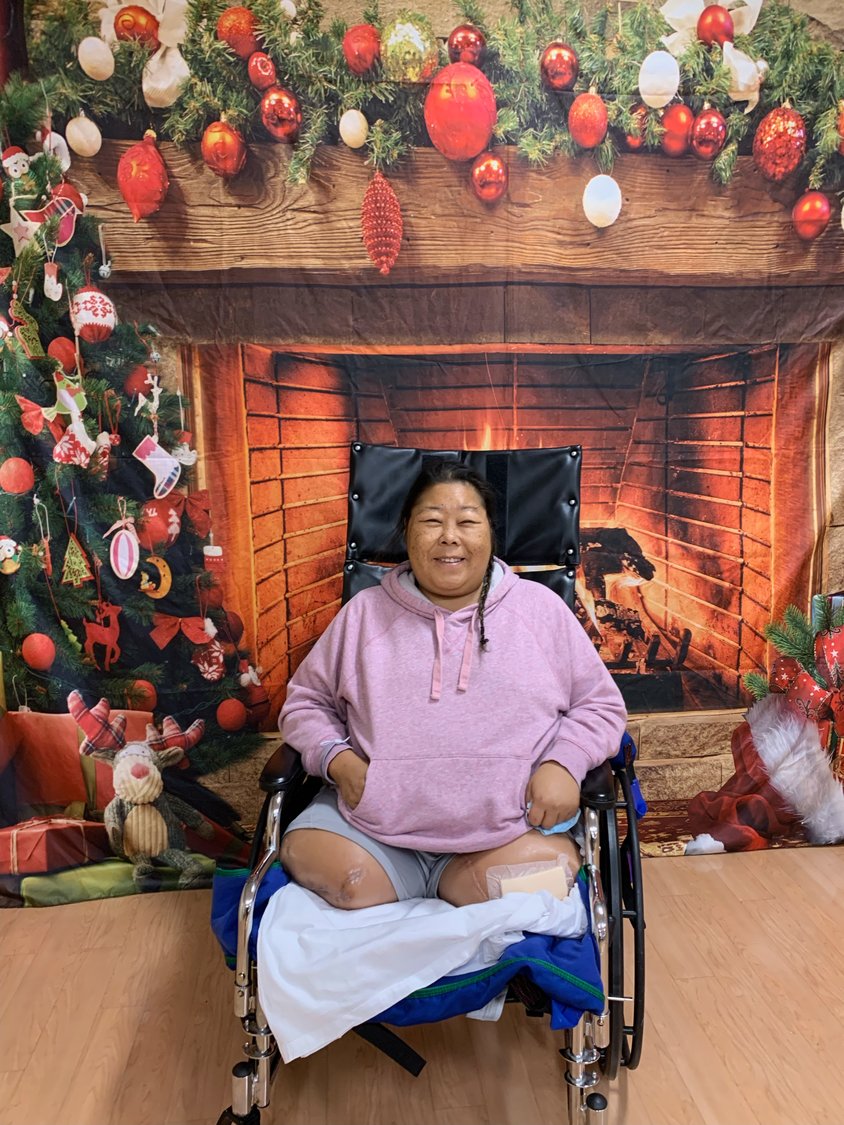Risa Asami hopes to lead a long life despite challenges
For most of her life, Risa Asami of Freeport faced health challenges caused by hereditary diabetes, high cholesterol, and high blood pressure. Her struggles escalated over the years, ultimately leading to the amputation of both of her legs.
Through it all, she has remained determined to lead a full and meaningful life.
She had the toes of her right foot amputated five years ago and underwent bypass surgery to restore blood flow. She spent two months in a rehab facility to learn how to walk again.
“I was in a rehab facility while it healed, and kind of learned how to walk like with no toes on the right foot,” Asami said. “But then I was able to return home and basically live a pretty normal autonomous life.”
The bypass surgery didn’t completely solve her circulation issues. Asami’s left leg weakened, and she experienced severe pain in her right leg, leading to another doctor’s visit in April of last year.
Doctors discovered a blockage and presented Asami with a difficult decision. They could provide temporary pain management or amputate her leg. She chose pain management, but it proved ineffective in the long term requiring constant treatment for fruitless results.
“Basically, I wasn’t getting sufficient blood flow to my leg,” Asami said. “I asked them how long the temporary treatment would last, and they said a month or two. I was like I’m not going through that type of surgery again that often.”
Her health issues led to vascular disease, which is characterized by the hardening and blockage of arteries. In Asami’s case, the disease first affected her toes, then the legs below the knee, and eventually the legs above the knee.
It was difficult for Asami to accept the idea of having her legs amputated, but she came to terms with it quickly. She believed amputation would let her live an autonomous life.
“At that point I was just like, cut them off, because at least then I can move on,” Asami said. “I was like this is the decision I need to make. Did I cry for a day or so? Yes. But it’s what I needed to do.”
Since the amputation surgery, Asami stays at the Amputee Walking School in Roslyn. The school provides training and support to amputees beyond physical therapy.
Asami believes that living in the rehab facility is her way of working toward her goal of getting a prosthetic and returning home.
Her day-to-day routine consists of physical and occupational therapy in the morning, followed by kidney dialysis.
Asami has three dialysis appointments weekly, which is the hardest part of her day as it takes up a lot of her time and drains her energy.
Despite her health battles, Asami maintains a full-time job at ECI, a marketing research company. An employee at ECI for five years, Asami has been working remotely since being in the rehab facility. Her job involves designing questionnaires, and collecting and analyzing data on consumer reactions.
If her physical ailments weren’t enough, she is facing financial difficulties while staying at the rehab facility despite having insurance. The coverage for her stay at the rehab facility is about to end and she is struggling to make ends meet as she is paying out of pocket for most things.
In addition to covering the cost of the rehabilitation, Asami needs to save money for future prosthetics and a wheelchair lift.
Oceanside prosthetist Robert Schulman of the Limb Kind Foundation, with over 30 years of experience in the field, said the prosthetic health care landscape is complex when it comes to insurance funding and financial responsibilities.
“One of the biggest issues is that it’s not just a one-time problem, it’s an ongoing issue,” Schulman said. “Health care organizations, in particular, have a continual issue with managing problems like this, it’s becoming increasingly common for people in these positions to encounter such problems.”
Asami is looking forward to working with a team of prosthetic experts in the coming weeks to get her ready for prosthetic legs by getting a pair of “stubbies.”
The prosthetic fitting process takes various factors into account, such as the type and level of amputation. When both limbs are missing above the knee, a common starting point is using stubbies, consisting of a socket and a rectangular platform at the bottom.
Knees are introduced to the prosthesis as the patient progresses, and gradual advancement continues until the patient is able to wear a full prosthesis that spans from the socket to the knee and down to the foot, allowing for normal walking.
“We do this so that they can begin the prosthetic process in a much safer manner and in a much less scary manner for them,” Schulman said.
Asami’s friends and colleagues have organized a fundraiser for March 11 from 6 to 9 p.m. at Jeremy’s Ale House.
The night of the fundraiser will also be the first time Asami will leave the rehabilitation school since November to make a special guest appearance and surround herself with family and the community.
For those who are unable to attend the event, a GoFundMe campaign is set up at tinyurl.com/HelpAsami.
“Freeport is just such a great time when it comes to people who are willing to help and we’re a very strong knit community full of very loving and giving people,” Asami said.

 44.0°,
Mostly Cloudy
44.0°,
Mostly Cloudy 




